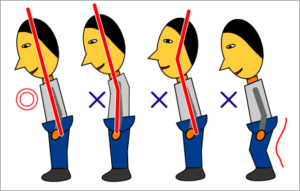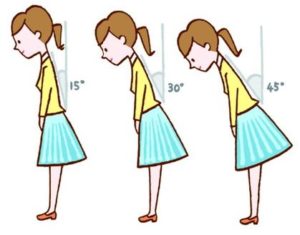
“In Japanese sense, being polite is to respect others!”
As you might see that Japanese people often bow to other instead of shaking hands, Ojigi (お辞儀:Bow) is the one of the Japanese communication action to greet and show their appreciation, apology and respect in every business scene.
There are three different degree of bow and each of them have different meanings.
• The light bow called “Eshaku (会釈)” is for a informal/casual greeting. Bend your upper body little bit front. People basically use this bow when we greet, especially seniors or guests.
• A general bow called “Keirei (敬礼)” is for a formal greeting or showing appreciation to someone. Bend your upper body around 30 degree front and see the point on floor 1 meter away.
The situation people prefer to use this bow;
○Greeting when get in/get out the office and meeting room
○When welcoming/sending guests
○When giving tea to guests
○ When visiting clients office
• A deep bow called “Saikeirei (最敬礼)” is the most polite bow. Bend your upper body around 45 degree front and see you feet. People use this bow when they want to show sincere appreciation and apology, for greeting for the important situation.
The situation people prefer to use;
○When telling sincere appreciation
○When telling sincere apology
○When asking important tasks
○When greeting at the important situation such as wedding and funeral
Bow is one of the necessary business manner for Japanese. For foreigners, it’s not familiar manner, however if you work at Japanese company or if you have Japanese clients, it’d better to master bow for showing your politeness.



